1997 BUICK CENTURY mirror
[x] Cancel search: mirrorPage 77 of 406

Section 2 Features and Controls
Here you can learn about the many standard and optional features on your Buick, and information on starting, shifting
and braking. Also explained are the instrument panel and the warning systems that tell you
if everything is working
properly
-- and what to do if you have a problem.
2-2
2-4
2-9
2- 14
2-15
2-16 2-17
2-17
2- 19
2-20
3-22
2-26
2-27
2-29
2-30
2-30
2-3 1
Keys
Door Locks
Remote Keyless Entry TrUnk
Theft
PASS-Key@ I1
New Vehicle “Break-In”
Ignition Positions Starting Your Engine
Engine Coolant Heater
Automatic Transaxle Operation
Parking Brake
Shifting Into PARK
(P)
Shifting Out of PARK (P)
Parking Over Things That Burn
Engine Exhaust
Running Your Engine While
You’re Parked 2-32
2-33
2-33
2-34
2-4 1
2-44
2-46
2-49
2-50
2-50
2-5 1.
2-52
2-52
2-53
2-54
2-55 Windows
Horn
Tilt Steering Wheel
Turn SignalMultifunction Lever
Exterior Lamps
Interior Lamps
Mirrors
Storage Compartments
Ashtrays and Lighter
Sun Visors
Auxiliary Power Connection
Sunroof
Cellular Phone Provisions
Instrument Panel
-- Your Information System
Instrument Panel Cluster
Warning Lights, Gages and Indicators
2-1
ProCarManuals.com
Page 121 of 406
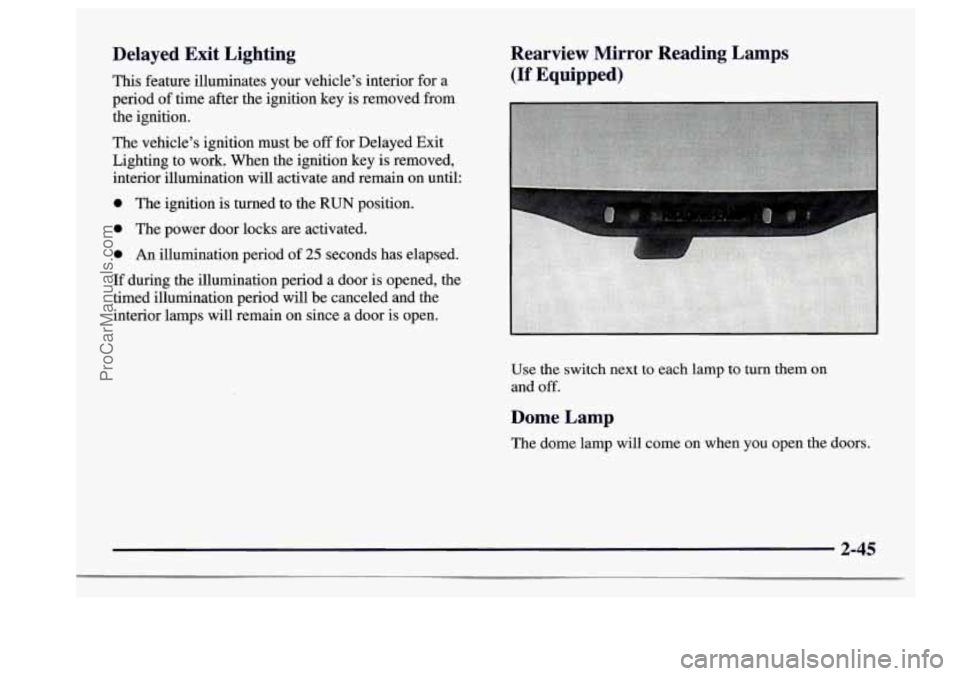
Delayed Exit Lighting
This feature illuminates your vehicle’s interior for a
period
of time after the ignition key is removed from
the ignition.
The vehicle’s ignition must be
off for Delayed Exit
Lighting to work. When the ignition key is removed,
interior illumination will activate and remain on until:
0 The ignition is turned to the RUN position.
0 The power door locks are activated.
0 An illumination period of 25 seconds has elapsed.
If during the illumination period a door is opened, the
timed illumination period will be canceled and the
interior lamps will remain on since a door is open.
Rearview Mirror Reading Lamps
(If Equipped)
Use the switch next to each lamp to turn them on
and
off.
Dome Lamp
The dome lamp will come on when you open the doors.
2-45
ProCarManuals.com
Page 122 of 406
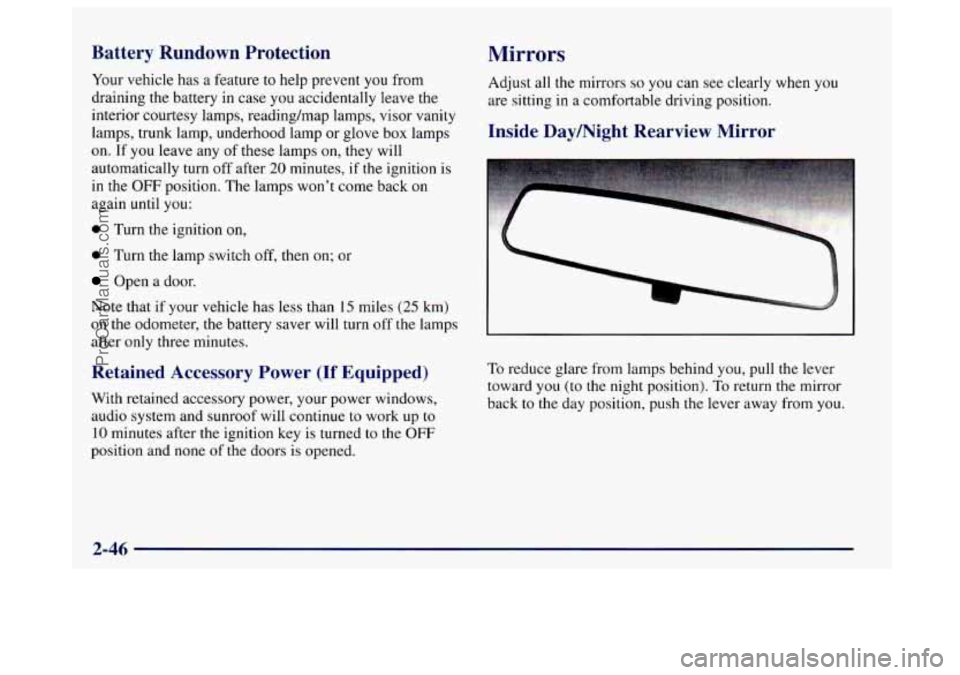
Battery Rundown Protection
Your vehicle has a feature to help prevent you from
draining the battery in case you accidentally leave the
interior courtesy lamps, reading/map lamps, visor vanity
lamps, trunk lamp, underhood lamp or glove box lamps
on. If you leave any of these lamps on, they will
automatically turn off after
20 minutes, if the ignition is
in
the OFF position. The lamps won’t come back on
again until you:
0 Turn the ignition on,
0 Turn the lamp switch off, then on; or
Open a door.
Note that if your vehicle has less than
15 miles (25 km)
on the odometer, the battery saver will turn off the lamps
after only three minutes.
Retained Accessory Power (If Equipped)
With retained accessory power, your power windows,
audio system and sunroof will continue to work
up to
10 minutes after the ignition key is turned to the OFF
position and none of the doors is opened.
Mirrors
Adjust all the mirrors so you can see clearly when you
are sitting in a comfortable driving position.
Inside Daymight Rearview Mirror
To reduce glare from lamps behind you, pull the lever
toward you (to the night position).
To return the mirror
back to the day position, push the lever away from you.
2-46
ProCarManuals.com
Page 123 of 406
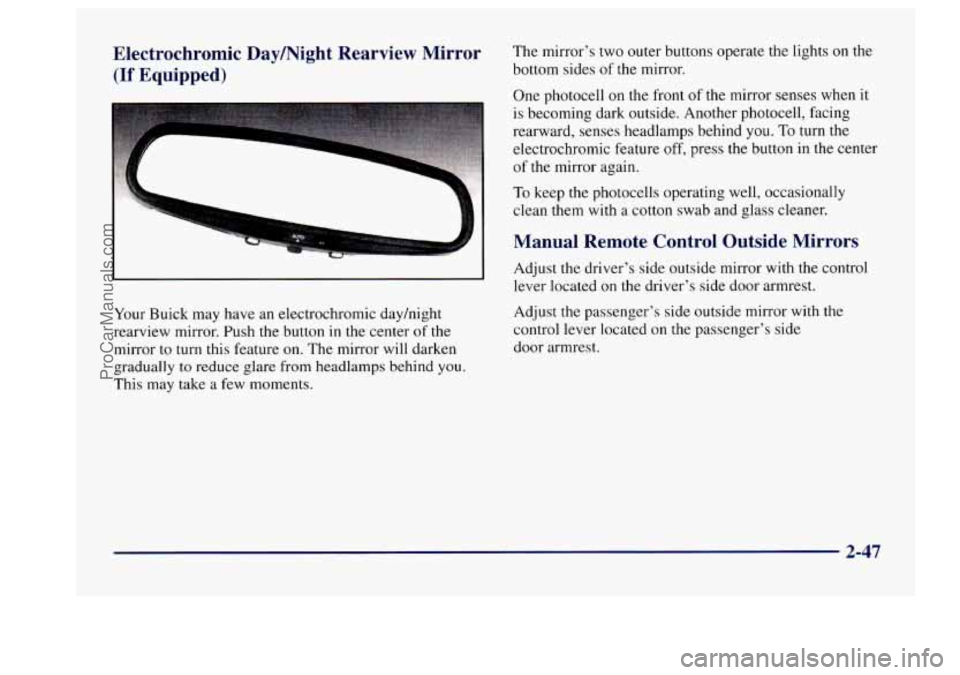
Electrochromic Daymight Rearview Mirror The mirror's two outer buttons operate the lights on the
(If Equipped) bottom sides of the mirror.
One photocell
on the front of the mirror senses when it
is becoming dark outside. Another photocell, facing
rearward, senses headlamps behind you.
To turn the
--
electrochromic feature off, press the button in the center
of the mirror again.
To keep the photocells operating well, occasionally
clean them
with a cotton swab and glass cleaner.
Manual Remote Control Outside Mirrors
Your Buick may have an electrochromic dayhight
rearview mirror. Push the button
in the center of the
mirror to turn this feature on. The mirror will darken
gradually to reduce glare from headlamps behind you.
This may take
a few moments. Adjust
the driver's side outside
mirror with the control
lever located on the driver's side door armrest.
Adjust
the passenger's side outside mirror with the
control lever located on the passenger's side
door armrest.
2-47
ProCarManuals.com
Page 124 of 406
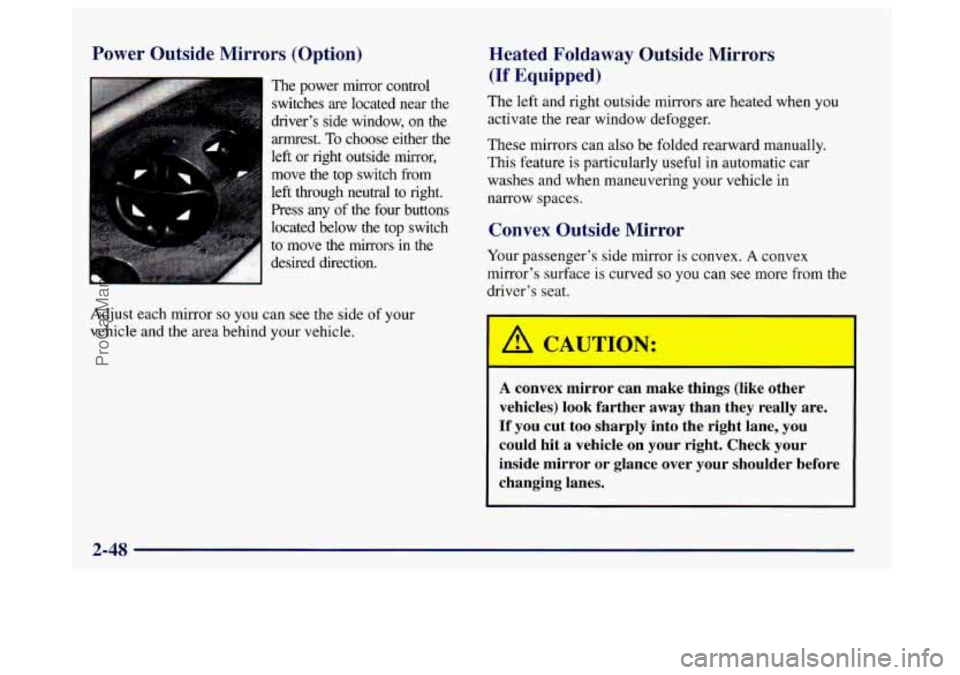
Power Outside Mirrors (Option)
The power mirror control
switches are located near the
driver’s side window,
on the
annrest. To choose either the
left or right outside mirror,
move the top switch from
left through neutral
to right.
Press any
of the four buttons
located below the top switch
to move the mirrors in the
I desired direction.
Adjust each mirror
so you can see the side of your
vehicle and the area behind your vehcle.
Heated Foldaway Outside Mirrors
(If Equipped)
The left and right outside mirrors are heated when you
activate the rear window defogger.
These mirrors can also be folded rearward manually.
This feature is particularly useful in automatic car
washes and when maneuvering your vehicle in
narrow spaces.
Convex Outside Mirror
Your passenger’s side mirror is convex. A convex
mirror’s surface is curved
so you can see more from the
driver’s seat.
A convex mirror can make things (like other
vehicles) look farther away than they really are.
If you cut too sharply into the right lane, you
could hit a vehicle on your right. Check your
inside mirror or glance over your shoulder before
changing lanes.
2-48
ProCarManuals.com
Page 127 of 406
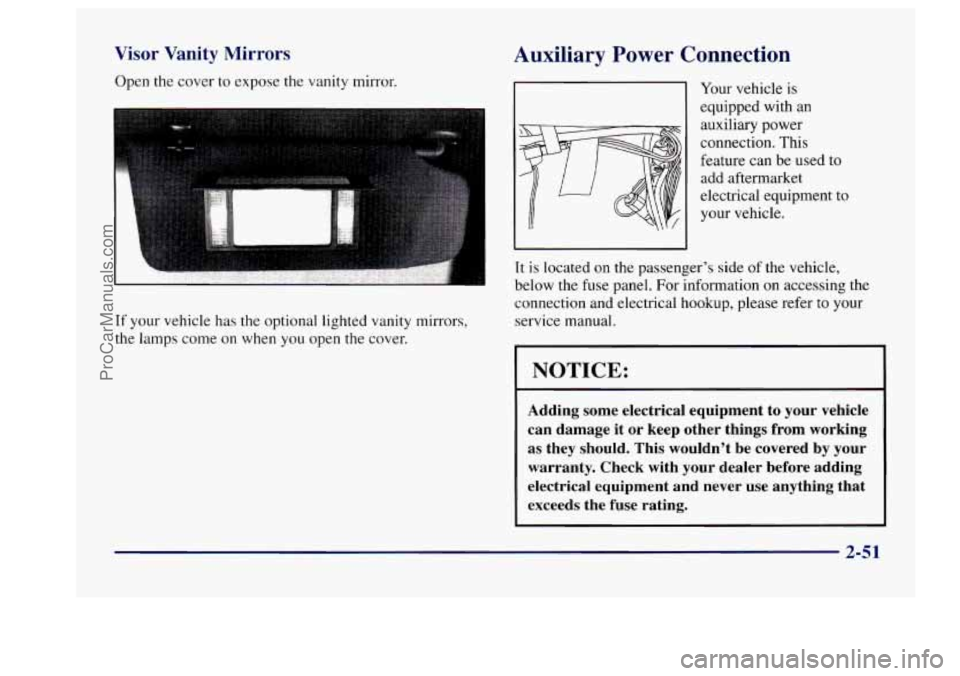
Visor Vanity Mirrors
Open the cover to expose the vanity mirror.
If your vehicle has the optional lighted vanity mirrors,
the lamps come
on when you open the cover.
Auxiliary Power Connection
Your vehicle is
equipped with an
auxiliary power
connection. This
feature can be used to
add aftermarket
electrical equipment
to
your vehicle.
It
is located on the passenger’s side of the vehicle,
below the fuse panel. For information
on accessing the
connection and electrical hookup, please refer to your
service manual.
1 NOTICE:
Adding some electrical equipment to your vehicle
can damage it or keep other things from working
as they should. This wouldn’t be covered by your
warranty. Check with your dealer before adding
electrical equipment and never use anything that
exceeds the fuse rating.
2-51
ProCarManuals.com
Page 199 of 406
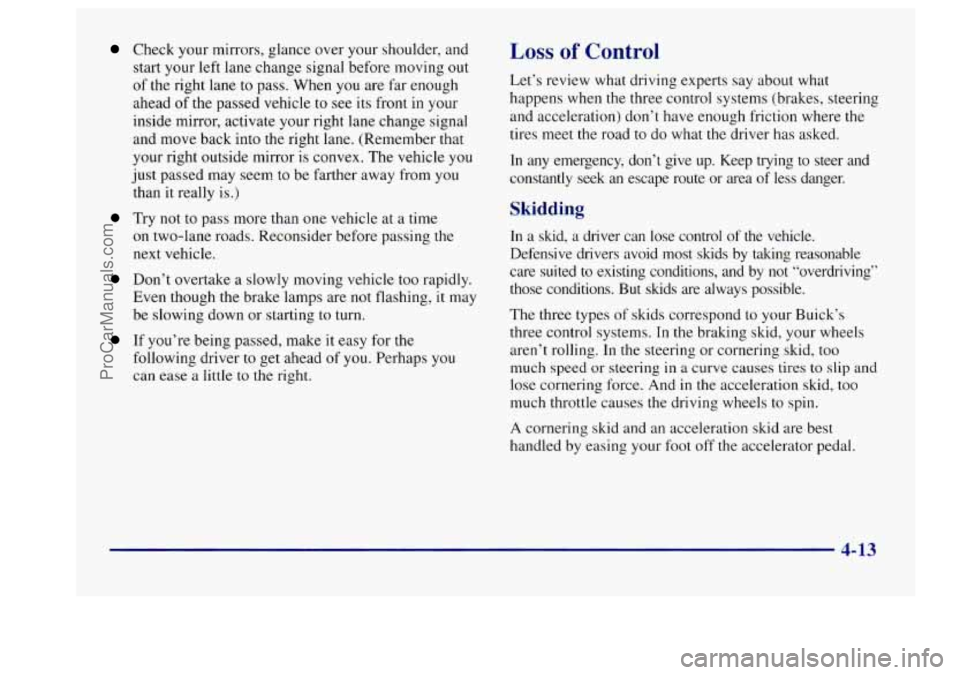
Check your mirrors, glance over your shoulder, and
start your left lane change signal before moving out
of the right lane to pass. When you are far enough
ahead of the passed vehicle
to see its front in your
inside mirror, activate your right lane change signal
and move back into the right lane. (Remember that
your right outside mirror
is convex. The vehicle you
just passed may seem to be farther away from you
than it really is.)
Try not to pass more than one vehicre at a time
on two-lane roads. Reconsider before passing the
next vehicle.
Don’t overtake a slowly moving vehicle too rapidly.
Even though the brake lamps are not flashing,
it may
be slowing down or starting to turn.
following driver
to get ahead of you. Perhaps you
can ease
a little to the right.
If you’re being passed, make it easy for the
Loss of Control
Let’s review what driving experts say about what
happens when
the three control systems (brakes, steering
and acceleration) don’t have enough friction where the
tires meet the road to do what
the driver has asked.
In any emergency, don’t give up. Keep trying to steer and
constantly seek an escape route or area of less danger.
Skidding
In a skid, a driver can lose control of the vehicle.
Defensive drivers avoid most skids by taking reasonable
care suited to existing conditions, and by not “overdriving”
those conditions. But skids are always possible.
The three types of skids correspond to your Buick’s
three control systems. In the braking skid, your wheels
aren’t rolling.
In the steering or cornering skid, too
much speed
or steering in a curve causes tires to slip and
lose cornering force. And
in the acceleration skid, too
much throttle causes the driving wheels to spin.
A cornering skid and an acceleration skid are best
handled by easing your foot off the accelerator pedal.
4-13
ProCarManuals.com
Page 200 of 406
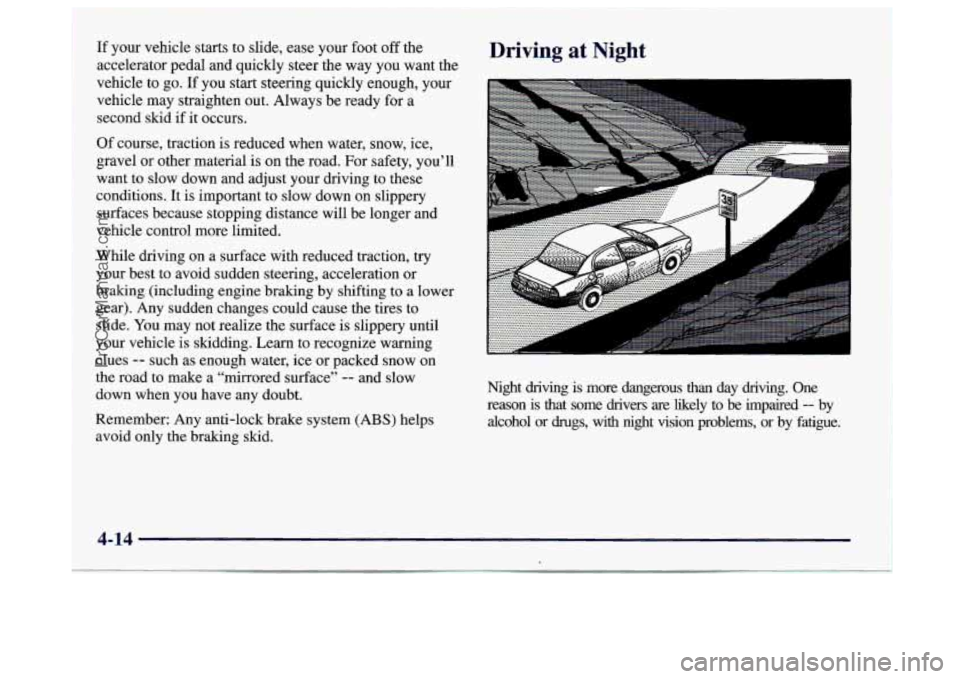
If your vehicle starts to slide, ease your foot off the
accelerator pedal and quickly steer the way you want the
vehicle to go. If you start steering quickly enough, your
vehicle may straighten out. Always be ready for a
second skid if it occurs.
Of course, traction is reduced when water, snow, ice,
gravel or other material is on the road. For safety, you’ll
want to slow down and adjust your driving
to these
conditions. It is important to slow down on slippery
surfaces because stopping distance will be longer and
vehicle control more limited.
While driving on a surface with reduced traction, try
your best to avoid sudden steering, acceleration or
braking (including engine braking by shifting to a lower
gear). Any sudden changes could cause the tires
to
slide. You may not realize the surface is slippery until
your vehicle is skidding. Learn to recognize warning
clues
-- such as enough water, ice or packed snow on
the road to make a “mirrored surface’’
-- and slow
down when you have any doubt.
Remember: Any anti-lock brake system (ABS) helps
avoid only the braking skid.
Driving at Night
Night driving is more dangerous than day driving. One
reason is that some drivers
are likely to be impaired -- by
alcohol or
drugs, with night vision problems, or by fatigue.
4-14 1
ProCarManuals.com